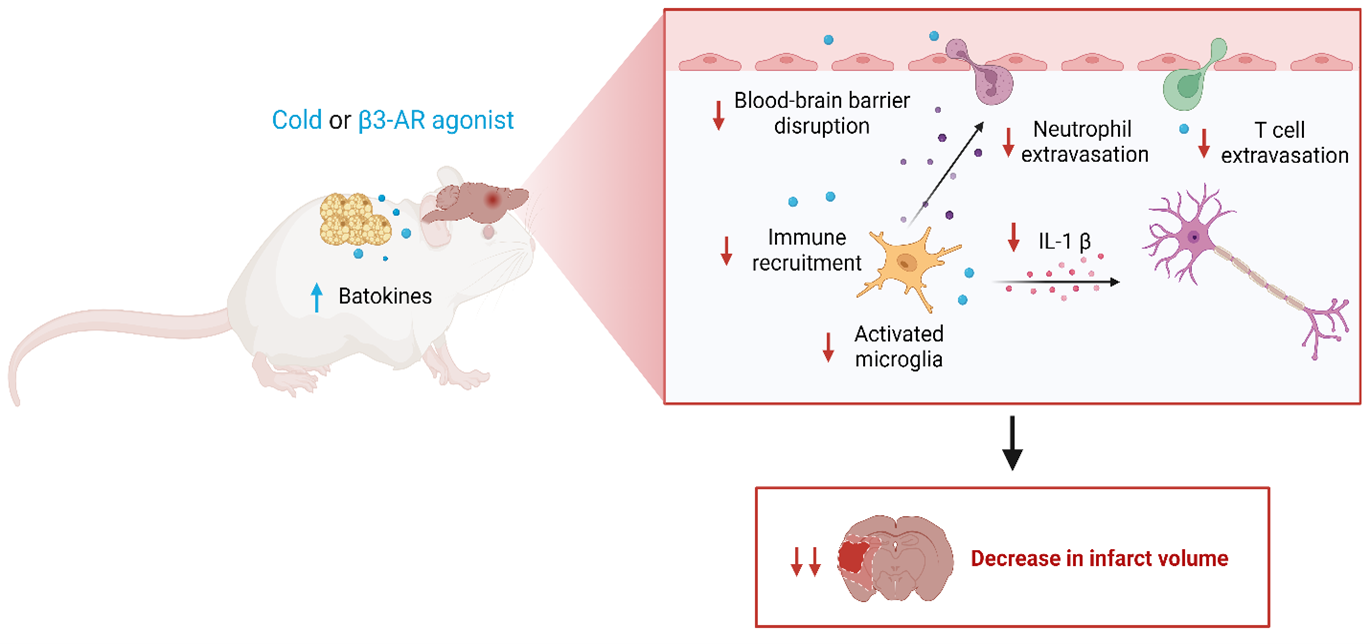Cardio-Metabolic Research
The group headed by Dr. Diaz-Cañestro integrates basic and translational research aimed to identify effective molecular targets and interventions to optimize cardio- and cerebrovascular health. Our ongoing research projects include:
- The role of brown adipose tissue in acute ischemic stroke (Figure 1): Brown adipose tissue (BAT) is recognized as an endocrine organ secreting a large number of factors known as “batokines” with both paracrine and autocrine roles. Batokines are known to act on peripheral organs including the heart, brain as well as on inflammatory and endothelial cells. We aim to identify and characterize batokines and explore their impact in an experimental model of ischemic stroke. Furthermore, we plan to translate experimental results obtained in mice into humans by using primary cell lines and samples from stroke patients.

- Figure 1: Schematic diagram of the working hypothesis. Upon cold exposure or beta-3 adrenergic receptor (β3-AR) agonist stimulation, BAT-derived factors will decrease neuroinflammation resulting in decreased infarct size and neurological deficits in a mouse model of ischemic stroke.
- The beneficial effects of exercise on cardio-metabolic diseases: By the elucidation of the molecular pathways underlying the beneficial effects of exercise, we aim to develop exercise-mimetics that may translate into novel therapeutic strategies for a broad spectrum of cardio-metabolic and cerebrovascular conditions. Accordingly, we plan to use multi-omics approach for systemically identification and characterization of dynamic changes in exercise-responsive factors. To achieve this goal our laboratory will use a broad range of methods ranging from in vitro and animal models to human studies.
Key publications
- Diaz-Canestro C, Merlini M, Bonetti NR, Liberale L, Wust P, Briand-Schumacher S, et al. Sirtuin 5 as a novel target to blunt blood-brain barrier damage induced by cerebral ischemia/reperfusion injury. Int J Cardiol. 2018;260:148-55.
- Liberale L, Diaz-Canestro C, Bonetti NR, Paneni F, Akhmedov A, Beer JH, et al. Post-ischaemic administration of the murine Canakinumab-surrogate antibody improves outcome in experimental stroke. Eur Heart J. 2018;39(38):3511-7.
- Diaz-Canestro C, Reiner MF, Bonetti NR, Liberale L, Merlini M, Wust P, et al. AP-1 (Activated Protein-1) Transcription Factor JunD Regulates Ischemia/Reperfusion Brain Damage via IL-1beta (Interleukin-1beta). Stroke. 2019;50(2):469-77.
- Diaz-Canestro C, Puspitasari YM, Liberale L, Guzik TJ, Flammer AJ, Bonetti NR, et al. MMP-2 knockdown blunts age-dependent carotid stiffness by decreasing elastin degradation and augmenting eNOS activation. Cardiovasc Res. 2022;118(10):2385-96.
- Diaz-Canestro C, Pentz B, Sehgal A, Montero D. Sex differences in cardiorespiratory fitness are explained by blood volume and oxygen carrying capacity. Cardiovasc Res. 2022;118(1):334-43.
- Diaz-Canestro C, Pentz B, Sehgal A, Yang R, Xu A, Montero D. Lean body mass and the cardiovascular system constitute a female-specific relationship. Sci Transl Med. 2022;14(667):eabo2641.
- Diaz-Canestro C, Chen J, Liu Y, Han H, Wang Y, Honore E, et al. A machine-learning algorithm integrating baseline serum proteomic signatures predicts exercise responsiveness in overweight males with prediabetes. Cell Rep Med. 2023;4(2):100944.
- Jin L, Diaz-Canestro C, Wang Y, Tse MA, Xu A. Exerkines and cardiometabolic benefits of exercise: from bench to clinic. EMBO Mol Med. 2024;16(3):432-44.